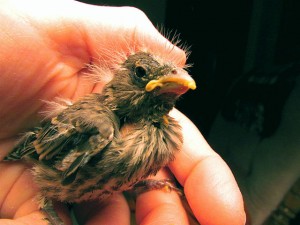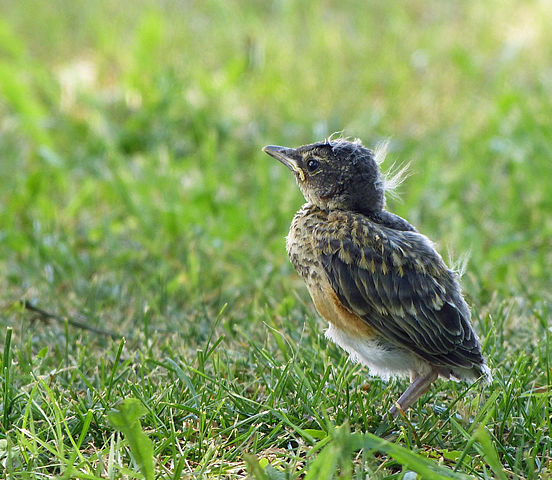What To Do If You Find a Baby Bird
Rescue or Not To Rescue, That Is The Question
It's that time of year again, with birds courting, laying eggs, and soon to be hatched fledglings hopping everywhere. This is the season I dread the most because it's when people start calling about baby birds and often dump the babies on my doorstep. For this blog post I thought it would be timely to cover what to do if you find a baby bird.
Before we begin, I want to caveat this post by saying that it's always best to leave wildlings in nature if you can, even if it means their demise. I know this is a hard thing to hear. After speaking with rehabilitators I've come to accept that survival during and after rehabilitation for most species of birds is very low. They just can't endure the stress of captivity. Put yourself in the shoes (over-sized feet?) of a baby bird bird. You're captured by giants, shoved into a cave with bars, fed food through a plastic syringe, you expect to be eaten by said large predatory giants that have taken you, your family is gone, and you are surrounded by new smells in a frightening environment with people oogling you. It makes sense for something as fragile as a 6 to 10 day old baby bird to be stressed to death. By leaving baby birds in their environments and providing some minimal amount of help if necessary you are giving the bird its best chance at survival. If it gets eaten or passes on then it becomes a part of the cycle of life, as food for something else, and its genes are not passed on. This is how nature works. For those of you with children this may be a bit difficult to convey without lots of tears but I'd suggest the story book "Everybody is Somebody's Lunch" by Cherie Mason. I do want to stress that I have great respect for bird and animal rehabilitators. They are under-paid and truly are wonderful people that are dedicated to wildlife. They do a great job when called upon.

On that note, let's discuss what you can do to help you asses the situation when you do find a baby bird. First, what did you find? Often times you'll see baby birds in various stages of feathering that have either fallen out of the nest, been pushed out by their more aggressive siblings, or jumped out on purpose. Begins with these steps;
Step 1. Figure Out What Life Stage The Bird In
Remember that birds all mature at different rates so there is no one good chart for all of them. This chart is a general guideline of songbird maturation. Check out the "Development of a Baby Bird Quick Reference Page" by the Messinger Woods Wildlife Care and Education Center for some pictures to supplement this list's time table.
| Day | Stage | Features |
| 0 | Egg | Egg in nest |
| 1 | Nestling | Young hatch, eyes closed, no feathers, weak, barely lift head for food, little to no sound, egg tooth prominent. |
| 2 | Nestling | Down may appear, still weak, holding head up for food, some sounds audible. |
| 3 | Nestling | Wing feathers begin to appear, down increases, eyes still closed, more vocal, egg tooth disappears |
| 4 | Nestling | Stronger, eyes may slit open slightly, feeds strongly, mature feathers begin to show on back and wings in clear tracts. |
| 5 | Nestling | Feathers clear on wings and back, though sides of body still slightly pink, feeds strongly, vocal. |
| 6 | Nestling | Feather sheaths fully formed with feather tips beginning to erupt, eyes fully open, feathered across most of body |
| 7 | Nestling | Stronger coordination of limbs and body, climbing around, eyes fully open, feathers unsheathing, more bird-like behavior (scratching, preening, hiding, etc.) |
| 8 | Nestling | Begins begging for food with entire body and wings, entirely feathered though feathers are still erupting. |
| 9-10 | Nestling | Close to fledged, begging, strong motor skills, looking more like small adult with duller colors, may practice flapping and stretching wings and legs. |
| 13-16 | Fledgling | Begins branching, hopping from branch to branch, looks like small adult, fully feathered though with short wings and tail, may leave nest, sleeps with head tucked. Still fed by adults while branching, may return to nest. |
| 16-28 | Fledgling | Does not return to nest, short flights, looks like adult, fully feathered, being fed by adults. May be found low on the ground or in shrubs. |
Step 2. Determine: Is the Bird In Imminent Danger (this should be done quickly along with step 1). If yes, keep reading, If No skip to the next step.
Now this sounds a lot easier than it is. Most people, when they see a helpless fledgling on the ground, want to rush in and help. Some birds like killdeer or turkeys nest on the ground. If you see an in-tact nest on the ground then leave it alone. If you find a nestling that has fallen from a nest, or if there are cats, dogs, children, cars, or other imminent hazards then you can try a few different options:
For Nestlings (if the nest is in tact, or you can see the nest): Try putting the nestling back. It's a myth that birds can smell you, they have very poor smell actually, so this isn't a factor to worry about. PLEASE DON'T USE THE SAME PATH BACK AND FORTH TO THE NEST. Your scent trail will lead any predator to the nest. Walk all over the area and be sure not to use the same path twice!
For Nestlings (if the nest is not in tact or you can't reach the nest): Hang a strawberry basket or pot (with holes in the bottom) in a tree, high enough away from danger, and place the nestling in (again, see note on approaching the nest above).
For Fledglings (if the bird is healthy and sound): If it's healthy and sound then it's normal for them to be on the ground. If dangers such as cats, dogs, etc. are around then try to remove the dangers first before moving the fledgling. If you can't remove the dangers then try moving the fledgling into a safe area. This sounds easier than it is, because you may end up moving it and it may hop into worse danger!
For Fledglings (if the bird is wounded): If the bird is wounded and there is imminent danger then you have two choices; either move the bird to a quiet safe spot and let it pass naturally or try to contact a rehabilitator. My vote, though callous sounding, is to leave it so that it may peacefully pass. There are a few exceptions that I break this rule for such as raptors, endangered species, or rare birds. DO NOT TAKE THE BIRD HOME TO TRY TO RAISE IT. You should never try to take a baby bird home to rear for two important reasons: 1. It's illegal under the migratory bird act and you need permits, 2. Most people don't know how to rehabilitate baby birds successfully. It's a grueling process that requires special training. Even those with the best intention may end up malnourshing the bird or causing harm.

Step 3. If No Danger Is Present Assess the Bird's Health
For Nestlings, No Danger Present (if the nest is in tact, or you can see the nest): Try putting the nestling back. It's a myth that birds can smell you, they have very poor smell actually, so this isn't a factor to worry about. PLEASE DON'T USE THE SAME PATH BACK AND FORTH TO THE NEST. Your scent trail will lead any predator to the nest. Walk all over the area and be sure not to use the same path twice!
For Nestlings, No Danger Present (if the nest is not in tact or you can't reach the nest): Hang a strawberry basket or pot (with holes in the bottom) in a tree, high enough away from danger, and place the nestling in.
For Fledglings, No Danger Present (if the bird is healthy and sound): If it's healthy and sound then it's normal for them to be on the ground. Leave the fledgling in the area and walk away. the parents are probably around and watching you! If you don't notice any parents after a few hours then you may need to consider the choice of either leaving it out there (because maybe you didn't really watch it and the parents are actually out there) or calling a rehabilitator.
For Fledglings, No Danger Present (if the bird is wounded): If the bird is wounded either move the bird to a quiet safe spot and let it pass naturally or try to contact a rehabilitator. My vote, though callous sounding, is to leave it so that it may peacefully pass. There are a few exceptions that I break this rule for such as raptors, endangered species, or rare birds. DO NOT TAKE THE BIRD HOME TO TRY TO RAISE IT. You should never try to take a baby bird home to rear for two important reasons: 1. It's illegal under the migratory bird act and you need permits, 2. Most people don't know how to rehabilitate baby birds successfully. It's a grueling process that requires special training. Even those with the best intention may end up mal-nourshing the bird or causing harm.
Here is a PDF resource with a flow chart that should help you make a good decision about whether to rescue or not. The Audubon Society of Portland also has a nice page about baby birds and rescue.
Again I want to stress that it's best to leave wild animals in the wild. The temptation to put on a red cape and go rushing in to be a hero is really strong. I'm guilty myself. Over the years I've had to let a lot of people down or ask people to turn away from this instinct. Rehabilitation has its place with birds and wildlife but you have to think through whether it's the right choice. I say, go with your gut.


